the place where Paleontology and Paleoanthropology meets Philately
Cuba
Dinosaurs, prehistoric animals, human evolution, paleontologist Carlos de la Torre, Charles Darwin on stamps and postmarks of Cuba
| << previous country | back to index | next country >> |
Contents:
- Country overview
- Philately of Cuba
- Official stamps of Cuba related to Paleontology
- Postal stationery of Cuba related to Paleontology and Paleoanthropology
- Commemorative postmarks of Croatia related to Paleontology
- References
- Acknowledgements
Cuba, officially the Republic of Cuba, is a sovereign state comprising the island of Cuba as well as Isla de la Juventud and several minor archipelagos. Cuba is located in the northern Caribbean where the Caribbean Sea, the Gulf of Mexico and the Atlantic Ocean meet.
Havana is the largest city and capital; other major cities include Santiago de Cuba and Camagüey. Cuba is the largest island in the Caribbean with over 11 million inhabitants.
From the 15th century, it was a colony of Spain until the Spanish–American War of 1898, when Cuba was occupied by the United States and gained nominal independence as a de facto United States protectorate in 1902.
As a fragile republic, in 1940 Cuba attempted to strengthen its democratic system, but mounting political radicalization and social strife culminated in a coup and subsequent dictatorship under Fulgencio Batista in 1952.
Since 1965, the state has been governed by the Communist Party of Cuba. The country was a point of contention during the Cold War between the Soviet Union and the United States, and a nuclear war nearly broke out during the Cuban Missile Crisis of 1962.
[R1]
The first stamps of Cuba were issues for the Spanish West Indies, for use in both Cuba and Puerto Rico, issued in April, 1855. Cuba has published its own stamps since 1873. [R2]
The first Paleontology related stamps of Cuba were issued in 1958 "100 anniversary Carlos de la Torre" that shows not only a portrait of the famous biologist and paleontologist but also some fossils. Since 1982, Cuba has issued many pictorial stamp sets with the theme of dinosaurs and prehistoric life. Due to USA embargo Cuba's post authority use very old equipment to produce their stamps that leads too many design errors such as image and perforation shift, as well as some color variations, as shown on some examples below:
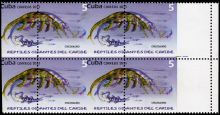 |
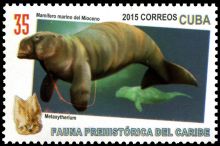 |
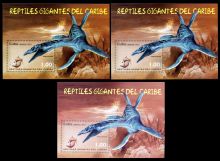 |
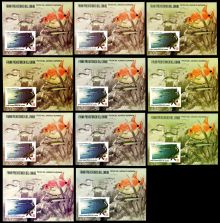 |
| Perforation error an color shift: on stamp from "Giant reptiles of Caribbean" set, issued in 2013 | Print Error: some extra lines (red/pink color) on stamp from "Prehistoric Fauna of Caribbean" set, issued in 2015 | Color variation: Three different colors of block from "Giant reptiles of Caribbean" set, issued in 2013 | Color variation: 11 (!) different color variations of block from "Prehistoric Fauna of Caribbean" set, issued in 2015 |
Official stamps of Cuba related to Paleontology and Paleoanthropology: dinosaurs and other prehistoric animals, human evolution, paleontologists, Charles Darwin
| 29.08.1958 "100th anniversary Carlos de la Torre" [1] | 03.02.1960 Surcharged stamps [1] | 31.03.1967 "Anthropology: Human Evolution" |
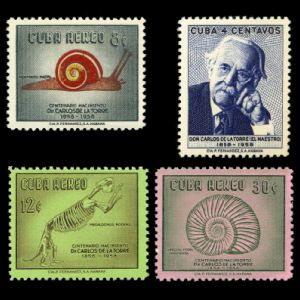 |
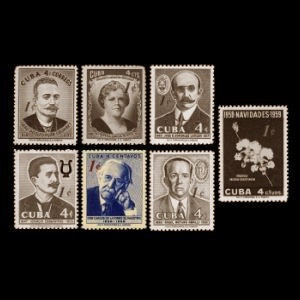 |
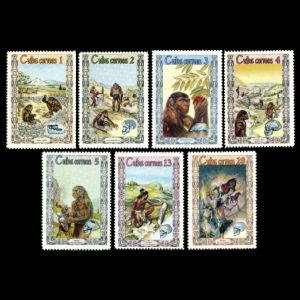 |
| 15.09.1982 "Prehistoric and modern Animals" | 14.02.1985 "Baconao National Park I" [2] | 25.06.1987 "Baconao National Park II" [2] |
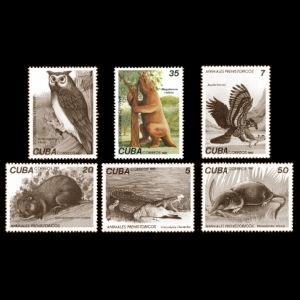
|
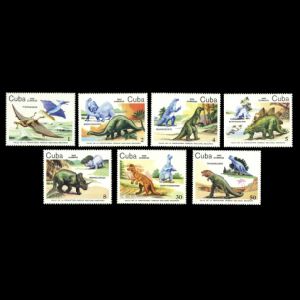 |
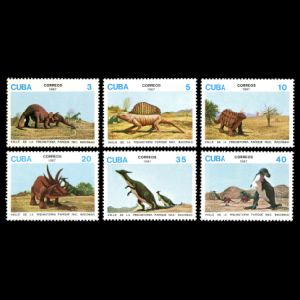
|
| 15.01.1990 "50th anniversary of Speleological Society" | 30.01.1996 "Scientists" | 30.10.1997 "Human evolution" |
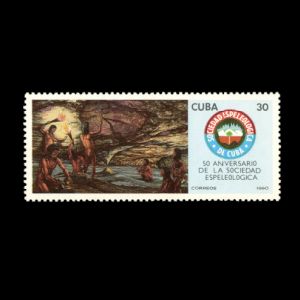 |
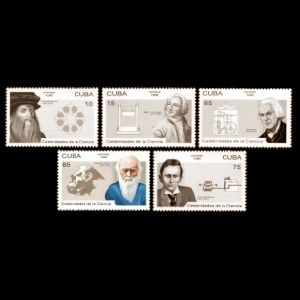 |
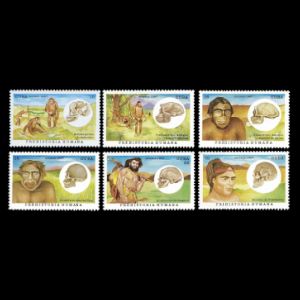 |
| 15.05.1998 "Evolution of the Chimpanzee" [3] | 10.03.1999 "Dinosaurs" | 27.12.2002 "Prehistoric and modern animals" |
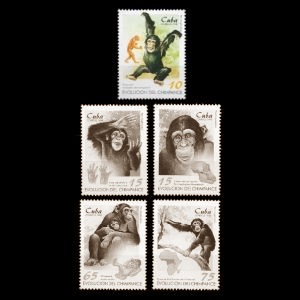 |
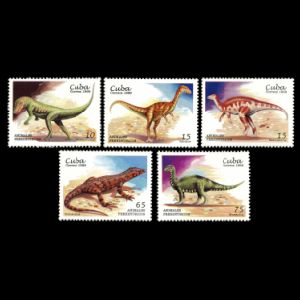 |
 |
| 20.01.2005 "Dinosaurs" | 24.05.2006 "Dinosaurs" | 15.05.2008 "150 anniversary of Carlos de la Torre" [1] |
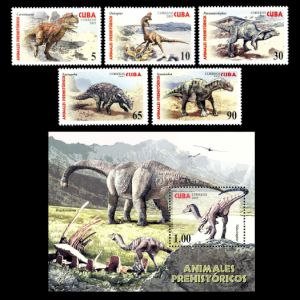 |
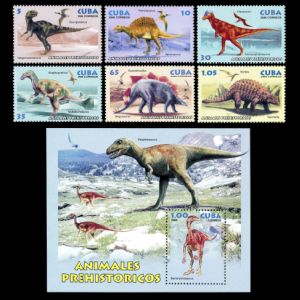 |
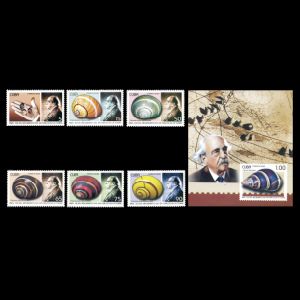 |
| 05.08.2008 "Paleolithic Men and Prehistoric Animals" | 12.02.2009 "Charles Darwin" | 03.04.2013 "Giant reptiles of Caribbean" |
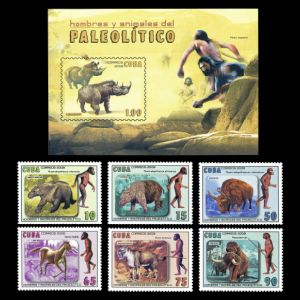 |
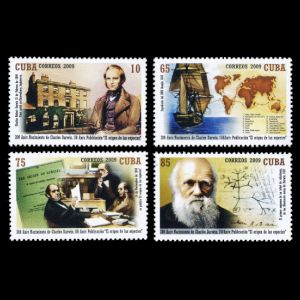 |
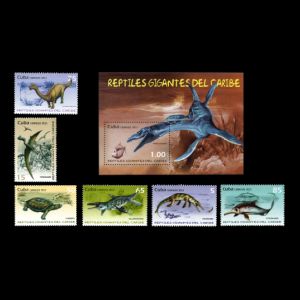 |
| 06.05.2015 "Prehistoric Fauna of Caribbean" | 31.01.2016 "Dinosaurs" [4] | |
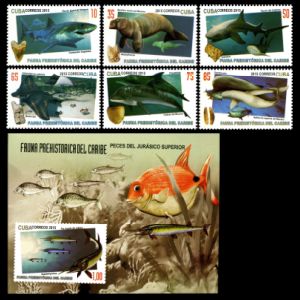 |
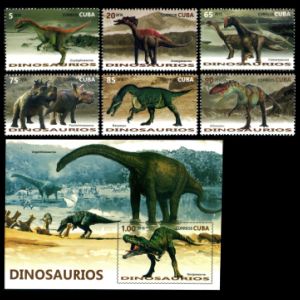 |
|
Notes:
[1] Carlos de Lattore (1856 - 1950) was the foremost Cuban naturalist. De la Torre was a naturalist of the old school, with broad interests in natural history.
He focused his research on mollusks, both living and extinct specimens.
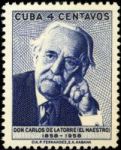
|
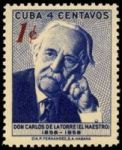
|
| Carlos de la Torre on stamp of Cuba 1958, MiNr.: 594 Scott: 607 | Carlos de la Torre on stamp of Cuba 1960, MiNr.: 645 SCott: 632 |
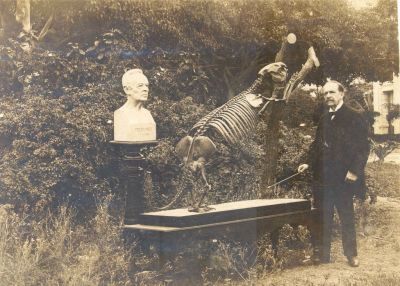
|
| Dr. Carlos de la Torre Huerta next to the bust of Cuban scientist Felipe Poey Aloy and the skeleton of a Cuban Giant Sloth (Megalocnus Rodens). Year 1910. Image credit: EcuRed.cu. |
In 1892 he traveled through the central part of Cuba Island, in the area from Cruces to Encrucijada, through the territories of Cienfuegos, Santa Clara and Sagua la Grande. During this expedition he found nearly complete skeleton of giant ground sloths Megalocnus rodens (originally Myomorphys cubensis) in the Baños de Ciego Montero and Jurassic Ammonite in the Baños de la Bija.
The skeleton of the sloth was mounted, at the same posture as shown on the stamp from 1958, in Cuban Academy of Sciences in Havana, nowadays Cuban Museum of Natural History.
De la Torre hosted many Smithsonian naturalists visiting Cuba and the nearby Caribbean islands; indeed, a visit to de la Torre was the first stop on the itinerary of any U.S. naturalist visiting Cuba. When the Toms Barrera expedition arrived in Cuba, de la Torre joined the group of American naturalists as they cruised the waters surrounding the island to collect specimens. [R3]
[2] Baconao Park is a large park region, located about 60 kilometers away from the city of Santiago de Cuba, with a total area of 848.57 km2. One of the attractions there is Prehistoric Valley. In the Valle de la Prehistoria visitors encounter dozens of life-size model dinosaurs sculpted in stone and other prehistoric creatures lurking in lush vegetation. [R4]
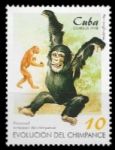
|
|
Proconsul primate on the background of Chimpanzee evolution stamp of Cuba 1998, MiNr.: 4106, Scott: 3918 |
[3] The first stamp of the set, face value of 10c shows the primate Proconsul in the background.
Proconsul is an extinct genus of primates that existed from 23 to 25 million years ago during the Miocene epoch. Fossil remains are found in Eastern Africa including Kenya and Uganda.
Four species have been classified to date: Proconsul africanus, Proconsul gitongai, Proconsul major and Proconsul meswae.
The four species differ mainly in body size. Environmental reconstructions for the Early Miocene Proconsul sites are still tentative and range from forested environments to more open, arid grasslands. [R5]
[4] This issue was planned on 31.01.2016, but appeared on the market in the middle of July 2016.
Therefore, the FDC is actually not the First Day Cover, but Souvenir Cover as it still dated 31.01.2016.
[5] Many stamps of prehistoric animals from 1960s to 1990s were based on illustrations of the famous Czechoslovakian paleoartist Zdenek Burian.
The following stamps depict the dinosaurs Iguanodon and Tyrannosaurus from the set of "Baconao National Park I", Cuba 1985 and "Dinosaurs", Laos 1988 that look almost identical.
Tyrannosaurus on the stamp of Laos, misnamed Trachodon.
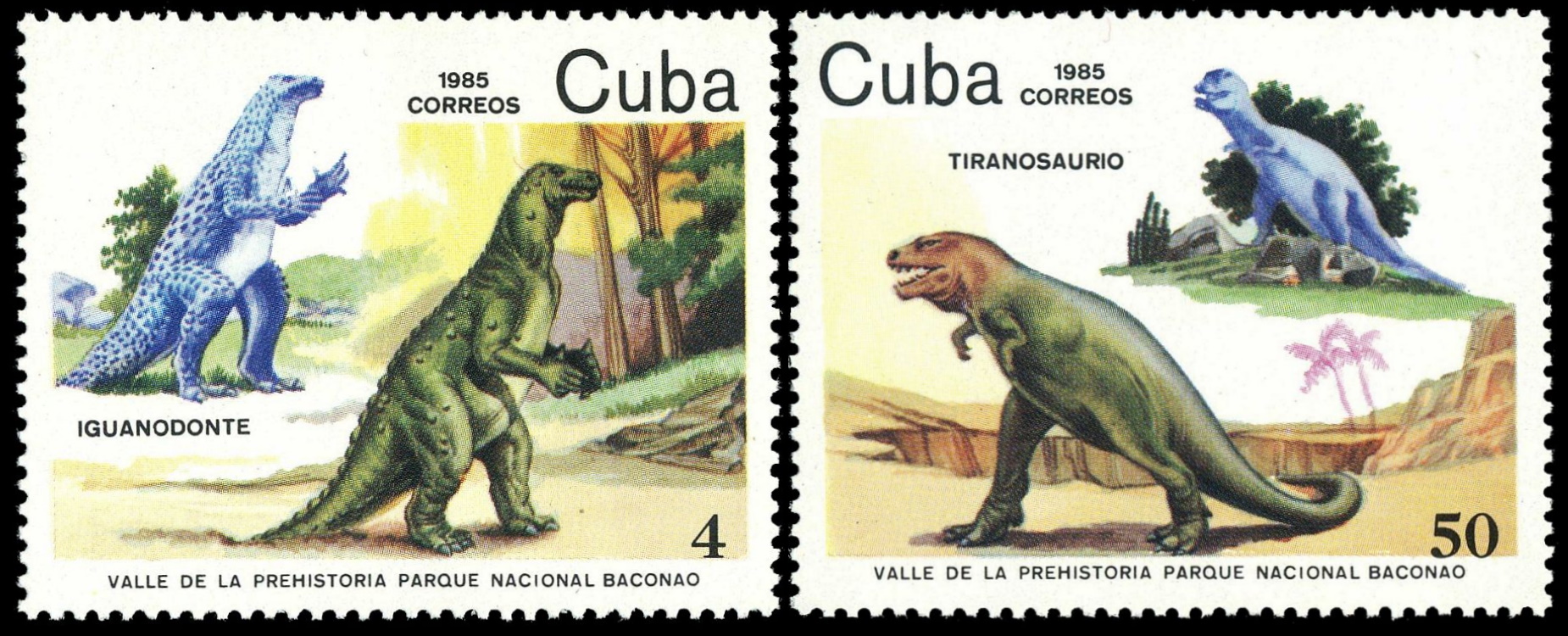
|
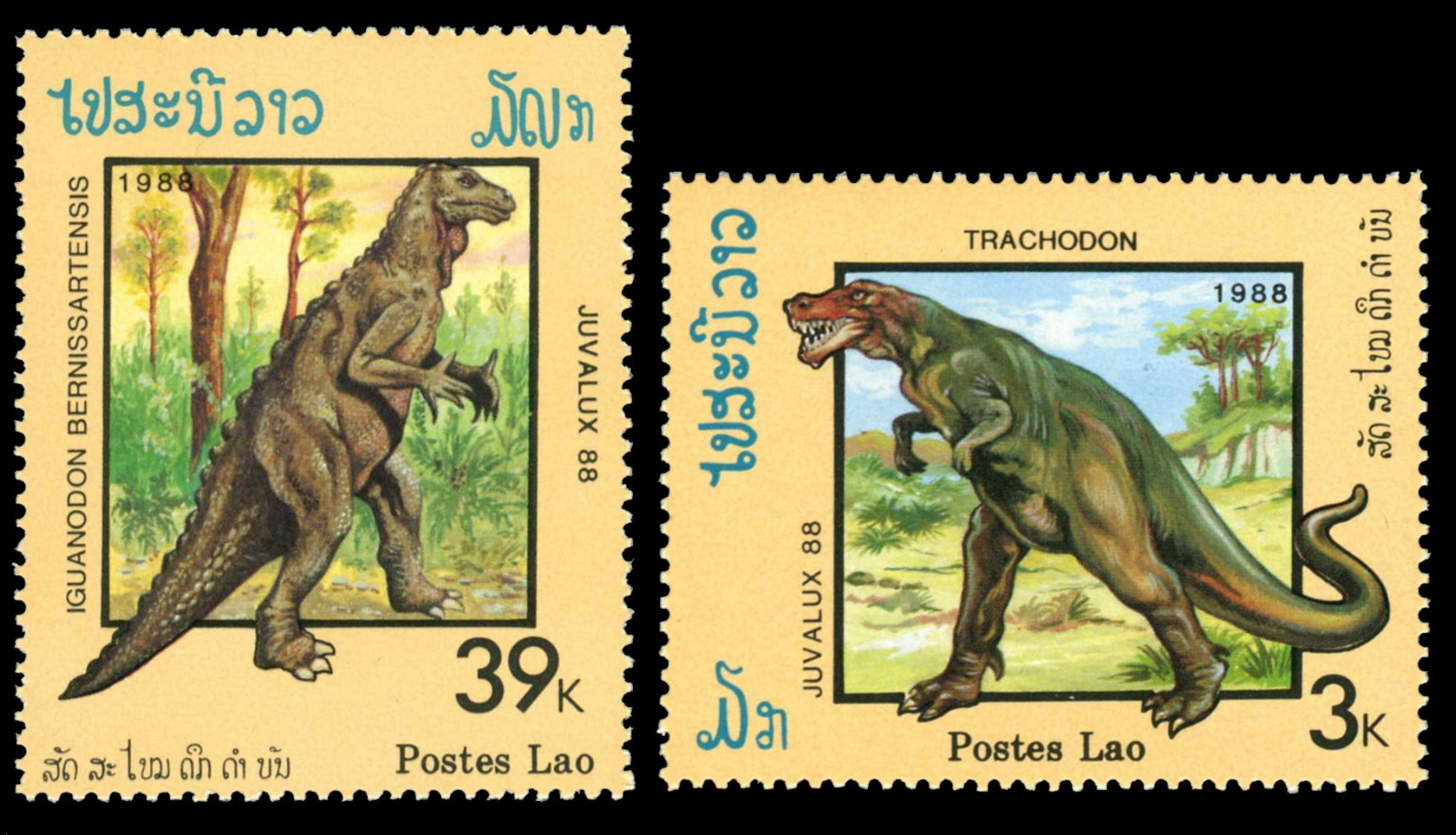
|
| Iguanodon and Tyrannosaurus dinosaurs on stamps of Cuba 1985 MiNr.: 2921, 2925 Scott: 2767, 2771. | Iguanodon and Tyrannosaurus (misnamed Trachodon) dinosaurs on stamps of Laos 1988 MiNr.: 1077, 862, Scott: 1075, 860. |
Post stationery of Cuba related to Paleontology and Paleoanthropology
No postal stationary of Cuba shows imprinted dinosaur or prehistoric animals stamps. However, there are some postcards with sculptures of dinosaurs and other prehistoric animals of "Prehistory Valley", Baconao Park [2], mostly without any stamp on the reverse side. Some others have regular stamp of Cuba at domestic postcard rate on the back.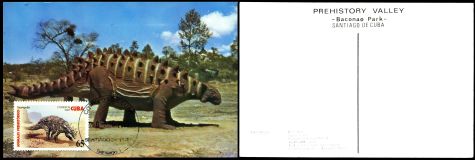 |
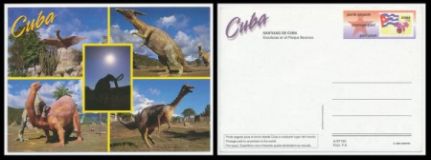 |
Commemorative postmarks of Cuba related to Paleontology and Paleoanthropology: dinosaurs and other prehistoric animals, early humans, Charles Darwin.
Legend is here| 31.03.1967 "Anthropology: Human Evolution" [FDC] | 14.02.1985 "Baconao National Park I" [FDC] [2] | 25.06.1987 "Baconao National Park II" [FDC] [2] |
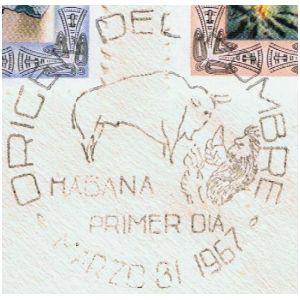 |
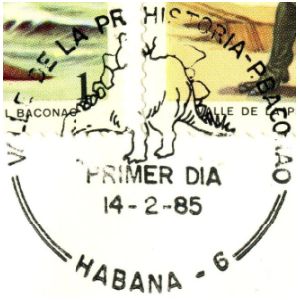 |
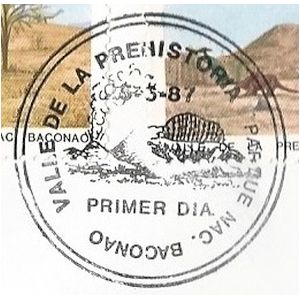 |
| 15.06.1992 "10th anniversary of Baconao National Park" [Sp] [2] | 30.10.1997 "Human evolution" [FDC] | 10.03.1999 "Dinosaurs" [FDC] |
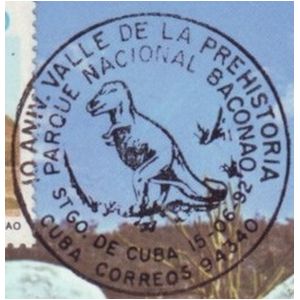
|
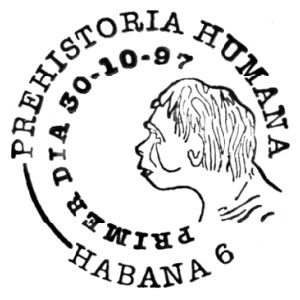 |
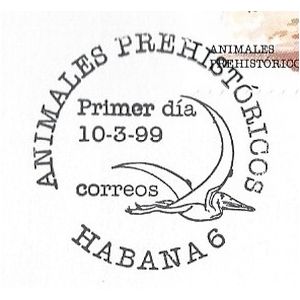 |
| 20.01.2002 "Prehistoric animals" [FDC] | 20.01.2005 "Dinosaurs" [FDC] | 24.05.2006 "Dinosaurs" [FDC] |
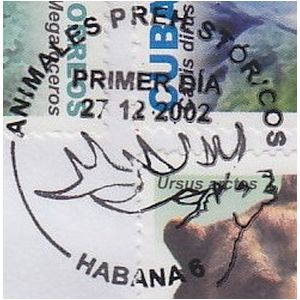
|
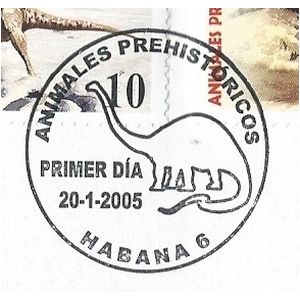
|
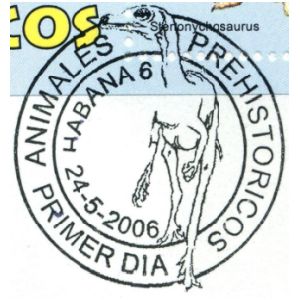 |
| 05.08.2008 "Paleolithic Men and Prehistoric Animals" [FDC] [C1] | 12.02.2009 "Charles Darwin" [FDC] | 03.04.2013 "Giant reptiles of Caribbean" [FDC] |
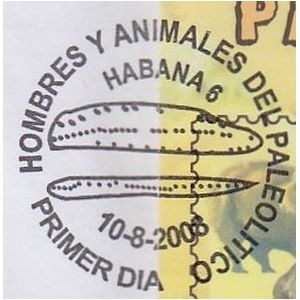 |
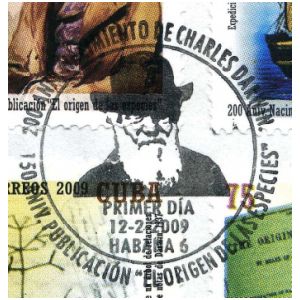 |
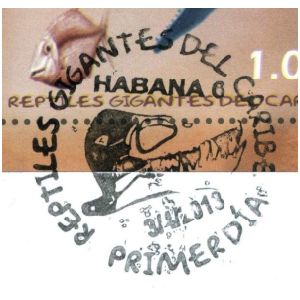 |
| 06.05.2015 "Prehistoric Fauna of Caribbean" [FDC] | 31.01.2016 "Dinosaurs" [FDC] [4] | |
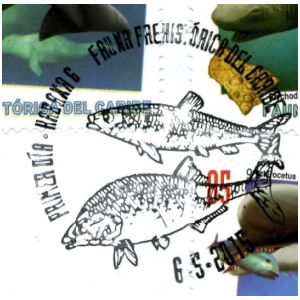 |
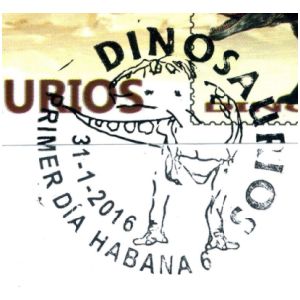 |
|
Notes:
[C1] Flint knife from Paleolithic times:
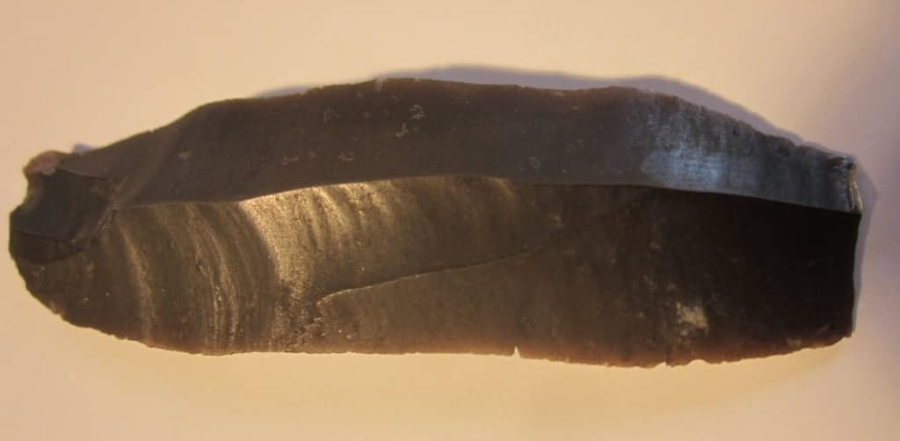
References:
- [R1] Cuba: Wikipedia, WikiTravel, FlagCounter.
- [R2] Postal History and Philately of Cuba:
Wikipedia,
Links to official website of the Post Authority, stamp catalog and a list of new stamps of Cuba are here. - [R3] Carlos de Lattore: Smithsonian Institution Archives, EcuRed.cu, Fossil matter, encyclopedia.com
- [R4] Baconao Park: Wikipedia, Tropical Cuban hHliday.
- [R5] Proconsul: Wikipedia
Acknowledgements:
Many thanks to Dr. Peter Voice from Department of Geological and Environmental Sciences, Western Michigan University, for reviewing the draft page and his very valuable comments.
| << previous country | back to index | next country >> |